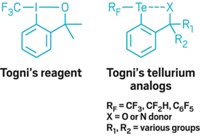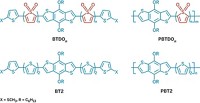Advertisement
Grab your lab coat. Let's get started
Welcome!
Welcome!
Create an account below to get 6 C&EN articles per month, receive newsletters and more - all free.
It seems this is your first time logging in online. Please enter the following information to continue.
As an ACS member you automatically get access to this site. All we need is few more details to create your reading experience.
Not you? Sign in with a different account.
Not you? Sign in with a different account.
ERROR 1
ERROR 1
ERROR 2
ERROR 2
ERROR 2
ERROR 2
ERROR 2
Password and Confirm password must match.
If you have an ACS member number, please enter it here so we can link this account to your membership. (optional)
ERROR 2
ACS values your privacy. By submitting your information, you are gaining access to C&EN and subscribing to our weekly newsletter. We use the information you provide to make your reading experience better, and we will never sell your data to third party members.
Synthesis
Better Organic Electronics Using Supercharged Thiophene
ACS Meeting News: Powerful fluorine oxidizing reagent adds oxygen to thiophene’s sulfur to generate new conducting materials
by Stephen K. Ritter
April 8, 2013
Thiophene-based materials have emerged as important organic semiconductors for making electronic devices such as solar cells, field-effect transistors, and light-emitting diodes. In the quest to better control the electronic properties and improve the stability of the oligomeric thiophene chains, chemists have set out to partially or completely oxidize thiophene’s sulfur. Adding oxygen to sulfur is quite the trick, however, because few reagents are powerful enough for the job.
Fluorine chemist Shlomo Rozen of Tel Aviv University, in Israel, has come up with one such approach as part of his group’s effort to develop “offspring” reagents of elemental fluorine. Fluorine is one of the strongest oxidizing reagents known, but its extreme reactivity is hard to control. To tame fluorine for oxygen-transfer reactions, one of its major uses, Rozen developed HOF•CH3CN, which is made by bubbling nitrogen-diluted F2 through aqueous acetonitrile.
Rozen described his group’s work in creating HOF•CH3CN and other easy-to-use fluorine derivatives during a symposium sponsored by the Division of Fluorine Chemistry at the American Chemical Society national meeting in New Orleans this week.
Rozen’s group used HOF•CH3CN to selectively prepare oligothiophenes containing both oxygenated and nonoxygenated thiophene units. The researchers transferred oxygen atoms to dibromothiophenes (shown) and then cross-coupled them with unoxidized thiophenes. The resulting partially oxidized oligothiophenes can be fully oxidized by further treatment with HOF•CH3CN (Chem. Eur. J., DOI: 10.1002/chem.201203936). The technique makes it possible to better regulate the electronic properties of the new materials: The prepared oligothiophenes have narrower electronic bandgaps and higher oxidation and reduction potentials compared with any other arrangement of oligothiophenes measured so far, Rozen says.
“Rozen’s discovery of a stable form of HOF by complexing it with acetonitrile has great potential for further developing this new class of organic semiconductors,” observes Columbia University’s Luis M. Campos. Campos is using Rozen’s reagent in his lab to tune the electronic properties of conjugated organic materials, such as molecular wires. Rozen’s “latest work with oligothiophenes shows how the energy levels can be modulated in a reliable fashion, opening up new possibilities to explore their applications,” Campos says.






Join the conversation
Contact the reporter
Submit a Letter to the Editor for publication
Engage with us on Twitter